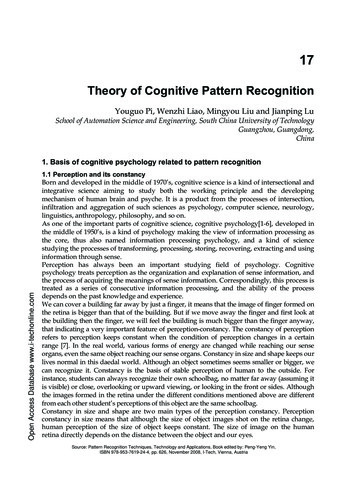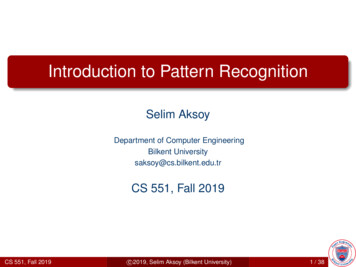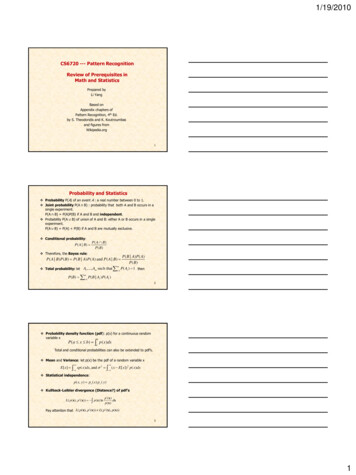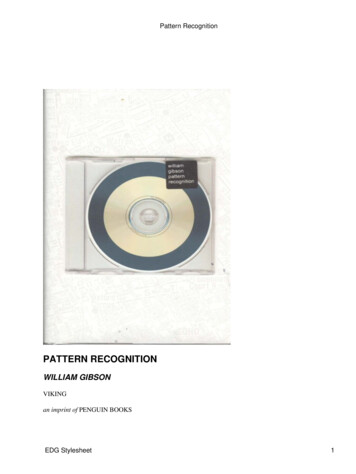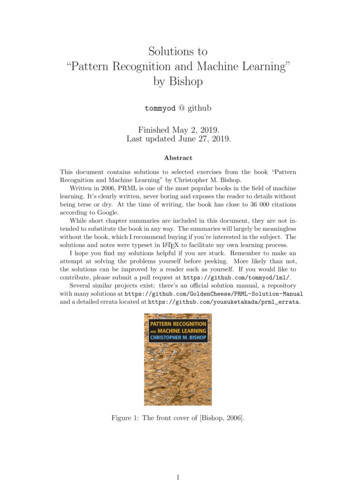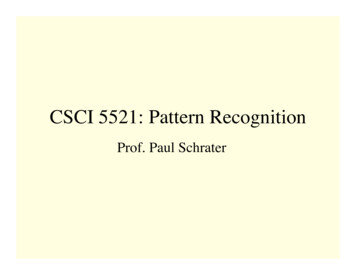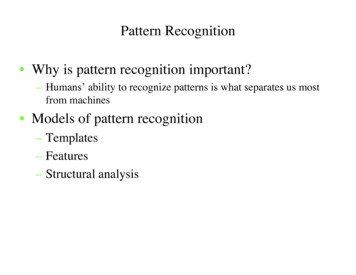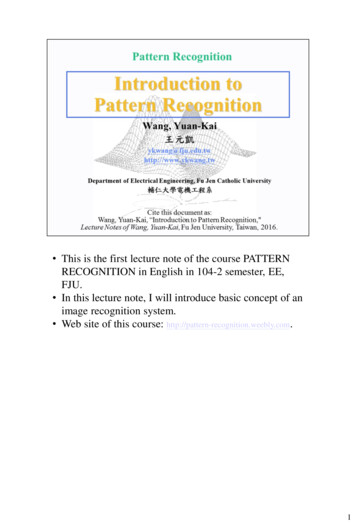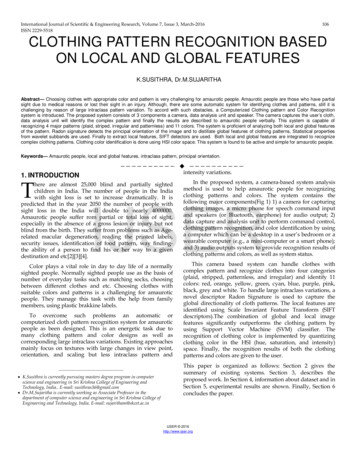
Transcription
International Journal of Scientific & Engineering Research, Volume 7, Issue 3, March-2016ISSN 2229-5518106CLOTHING PATTERN RECOGNITION BASEDON LOCAL AND GLOBAL FEATURESK.SUSITHRA, Dr.M.SUJARITHAAbstract— Choosing clothes with appropriate color and pattern is very challenging for amaurotic people. Amaurotic people are those who have partialsight due to medical reasons or lost their sight in an injury. Although, there are some automatic system for identifying clothes and patterns, still it ischallenging by reason of large intraclass pattern variation. To accord with such obstacles, a Computerized Clothing pattern and Color Recognitionsystem is introduced. The proposed system consists of 3 components a camera, data analysis unit and speaker. The camera captures the user’s cloth,data analysis unit will identify the complex pattern and finally the results are described to amaurotic people verbally. This system is capable ofrecognizing 4 major patterns (plaid, striped, irregular and patternless) and 11 colors. The system is proficient of analyzing both local and global featuresof the pattern. Radon signature detects the principal orientation of the image and to distillate global features of clothing patterns, Statistical propertiesfrom wavelet subbands are used. Finally to extract local features, SIFT detectors are used. Both local and global features are integrated to recognizecomplex clothing patterns. Clothing color identification is done using HSI color space. This system is found to be active and simple for amaurotic people.Keywords— Amaurotic people, local and global features, intraclass pattern, principal orientation.1. INTRODUCTIONT—————————— ——————————intensity variations.here are almost 25,000 blind and partially sightedchildren in India. The number of people in the Indiawith sight loss is set to increase dramatically. It ispredicted that in the year 2050 the number of people withsight loss in the India will double to nearly 4000000.Amaurotic people suffer rom partial or total loss of sight,especially in the absence of a gross lesion or injury but notblind from the birth. They suffer from problems such as Agerelated macular degeneration, reading the printed labels,security issues, identification of food pattern, way findingthe ability of a person to find his or her way to a givendestination and etc[2][3][4].In the proposed system, a camera-based system analysismethod is used to help amaurotic people for recognizingclothing patterns and colors. The system contains thefollowing major components(Fig 1) 1) a camera for capturingclothing images, a micro phone for speech command inputand speakers (or Bluetooth, earphone) for audio output; 2)data capture and analysis unit to perform command control,clothing pattern recognition, and color identification by usinga computer which can be a desktop in a user’s bedroom or awearable computer (e.g., a mini-computer or a smart phone);and 3) audio outputs system to provide recognition results ofclothing patterns and colors, as well as system status.Color plays a vital role in day to day life of a normallysighted people. Normally sighted people use as the basis ofnumber of everyday tasks such as matching socks, choosingbetween different clothes and etc. Choosing clothes withsuitable colors and patterns is a challenging for amauroticpeople. They manage this task with the help from familymembers, using plastic brakkine labels.This camera based system can handle clothes withcomplex pattern and recognize clothes into four categories(plaid, stripped, patternless, and irregular) and identify 11colors: red, orange, yellow, green, cyan, blue, purple, pink,black, grey and white. To handle large intraclass variations, anovel descriptor Radon Signature is used to capture theglobal directionality of cloth patterns. The local features areidentified using Scale Invariant Feature Transform (SIFTdescriptors).The combination of global and local imagefeatures significantly outperforms the clothing pattern byusing Support Vector Machine (SVM) classifier. Therecognition of clothing color is implemented by quantizingclothing color in the HSI (hue, saturation, and intensity)space. Finally, the recognition results of both the clothingpatterns and colors are given to the user.IJSERTo overcome such problems an automatic orcomputerized cloth pattern recognition system for amauroticpeople as been designed. This is an energetic task due tomany clothing pattern and color designs as well ascorresponding large intraclass variations. Existing approachesmainly focus on textures with large changes in view point,orientation, and scaling but less intraclass pattern � K.Susithra is currently pursuing masters degree program in computerscience and engineering in Sri Krishna College of Engineering andTechnology, India. E-mail: susithras36@gmail.com Dr.M.Sujaritha is currently working as Associate Professor in thedepartment of computer science and engineering in Sri Krishna College ofEngineering and Technology, India. E-mail: sujaritham@skcet.ac.inThis paper is organized as follows: Section 2 gives thesummary of existing systems. Section 3, describes theproposed work. In Section 4, information about dataset and inSection 5, experimental results are shown. Finally, Section 6concludes the paper.IJSER 2016http://www.ijser.org
International Journal of Scientific & Engineering Research, Volume 7, Issue 3, March-2016ISSN 2229-5518107In all these works [2][3][4][5][6][7], the needs of blindpeople are considered. Existing system [5][6][7] focus onclothing pattern which possess large change in viewpoint,orientation and scaling , but less with intraclass and intensityvariations. The proposed system has been designed toidentify cloth pattern where the intraclass and intensityvariations are more.3. PROPOSED WORKFIG1:OVERVIEWARCHITECTUREOFThe proposed work is for developing an assistive systemwhich automatically recognizes the color and cloth pattern foramaurotic people. A portable camera can be mounted upon apair of glass to capture the cloth pattern. These images areapplied through the input of wearable computer. Dataanalysis unit identifies the color and pattern of the cloth.Finally, a speech based audio output provides the color andpattern of the cloth.The proposed system consists of two major divisions.They are (1) Texture Recognition (2) color Recognition. Thework flow of the proposed system is shown in Fig 2.PROPOSED2. RELATED WORKEfficient systems are being developed to improve the lifequality and safety of amaurotic people. The systems such asbanknote recognition, way finding, display reading etc.,[2],[3],[4] plays important role in their day-to-day activities.The another main area where a color blind person faces aproblem is that, selecting clothes of desired colors andpatterns without the help of the another person[5][6][7].IJSERXiaodong Yang [5], proposed a Confidence Margin BasedFeature Combination, to select cloth and color for blindpeople. The system employed Radon signature to captureglobal directionality features and was found to be 92.55%efficient , structural information of texture are employed byusing SIFT . On the other hand, it was observed that thecombination of multiple complementary features usuallyachieves better results than the most discriminativeindividual feature.Dhongade M [6], proposed a new method that capturesGlobal features from image using DWT GLCM (Gray Levelco-occurrence matrix) and it is combined with SURF localfeatures. The concatenated vector is given as an input to SVM(Support Vector Machine). Even though GLCM DWTimprove accuracy, the complexity is high and its timeconsuming process.Tian [7], proposed a new method to match clothes frompair of clothing images. Texture analysis is done by usingRadon transform, wavelet features and co-occurrence matrixto handle illumination changes and rotations. Radontransform is employed for estimating the orientation oftexture patterns and Histogram equalization is performed todecrease illumination changes. For each wavelet sub images,co-occurrence matrix for gray texture analysis is calculated.Finally, the texture matching is performed based on statisticalclassification included six features e.g. mean, variance,smoothness, energy, homogeneity, and entropy. However,this system is not able to automatically recognize clothingpatterns.FIG 2: WORK FLOW OF PROPOSED SYSTEM3.1 TEXTURE RECOGNITIONIn general, to identify the cloth pattern both the local andglobal features are extracted from the input image.3.1.1 Radon Signature:Radon Signature is to characterize the directionality featureof clothing patterns. Radon Signature (RadonSig) is based onthe Radon transform which is commonly used to detect theprincipal orientation of an image. The Radon transform of a 2D function f (i, j) is defined a R(r, θ) - - f(i, j)δ(r-icosθ-jsinθ)didj(1)Where r is the perpendicular distance of a projection lineto the origin and θ is the angle of the projection line. Theinput image (Fig 3) is then rotated according to this dominantdirection to achieve rotation invariance.To retain the consistency of Radon transform for differentprojection orientations (Fig 4), it is done based on themaximum disk area instead of the entire image.IJSER 2016http://www.ijser.org
International Journal of Scientific & Engineering Research, Volume 7, Issue 3, March-2016ISSN 2229-5518The large intra class variations of clothing patterns alsoreflect as images in the same category present large changesof color or intensity.108L 1Entropy (et) p(zi )log 2 p(zi )i 0(5)Where Zi and p (Zi ), i 0, 1, 2. . . L 1 is the intensity leveland corresponding histogram; L is the number of intensitylevels; m L 1i 0 p(zi )zi is the average intensity level. Statisticalvalues are extracted from the input image (refer FIG 3). Theextracted values are given in Table I.TABLE I EXTRACTED STATISTICAL VALUESFIG 3: INPUT IMAGE (PLAID)FeaturesValuesVariance (vr)2423.57279511854Energy (E)1Uniformity (sd)49.2297958061837Entropy (et)1.3411329484789IJSER3.1.3 Scale Invariant Feature Transform Bag of WordOne of the most general and frequently used algorithmsfor category recognition is the bag of Words. This Algorithmgenerates a histogram, which is the distribution of visualwords found in the test image. The purpose of the Bow modelis representation. Representation deals with feature detectionand image representation. Features must be extracted fromimages in order to represent the images as histograms.FIG 4: FEATURE VECTORS OF RADON SIGNATURE3.1.2 Statistics of Wavelet Sub BandsStatistical features are well adapted to analyze textureswhich lack background clutter and have uniform Statisticalproperties.DWT transforms the spatial domain pixels intofrequency domain information that are represented inmultiple sub-bands, representing different time scale andfrequency points. Four statistical values including variance,energy, uniformity, and entropy to all wavelet sub bands areemployed. Thus, the STA is a feature with the dimension of48 (3 4 4). The four normalized statistical values extractedfrom each wavelet sub-band can be computed by thefollowing equations (2-5):L 1variance(vr) L 1i 0(zi m)2 p(zi )(L 1)energy(E) (zi m)3 p(zi )/(L 1)2i 02uniformity(sd) L 1i 0 p (zi )(2)(3)(4)There are certain features or characteristics that can beextracted and define what the image is. Features are thendetected and each image is represented in different patches.In order to represent these patches as numerical vectors weused SIFT descriptors to convert each patch into a 128dimensional vector. SIFT is used for reliable recognition sinceit has the benefits such as the features extracted from thetraining image be detectable even under changes in imagescale, noise and illumination. After converting each patch intonumerical vectors, each image is a collection of128dimensional vector. Detectors are used to detect interestpoints by searching local extrema in a scale space; descriptorsare employed to compute the representations of interestpoints based on their associated support regions. We performL2-norm and inverse document frequency (IDF)normalization of BOW histograms.3.1.4 Support Vector Machine (SVM) ClassifierSupport Vector Machine (SVM) is primarily a classifiermethod that performs classification tasks by constructinghyper planes in a multidimensional space that separates casesof different class labels.SVM supports both regression and classification tasks andcan handle multiple continuous and categorical variables.IJSER 2016http://www.ijser.org
International Journal of Scientific & Engineering Research, Volume 7, Issue 3, March-2016ISSN 2229-5518In the proposed system, the extracted global and localfeatures are combined to recognize clothing patterns by usinga support vector machines (SVM s) classifier. It is to classifythe clothing patterns into four different categories (plain,plaid, stripe and patternless) for pattern recognition system.SVM finds a maximum margin hyperplane in the featurespace.combinations of descriptorsdemonstrated in Table II.andtrainingsetsareTABLE IIRECOGNITION ACCURACY UNDER DIFFERENT VOLUMES OF CLOTHINGPATTERN DATASETMETHOD3.2 CLOTHING COLOR RECOGNITIONClothing color identification is based on the normalizedcolor histogram of each clothing image in the HSI color space.The key idea is to quantize color space based on therelationships between hue, saturation, and intensity. Inparticular, for each clothing image, our color identificationmethod quantizes the pixels in the image to the following 11colors: red, orange, yellow, green, cyan, blue, purple, pink,black, grey, and white. The detection of colors of white, black,and gray is based on the saturation value S and intensityvalue I. For other colors (i.e., red, orange, yellow, green, cyan,blue, purple, and pink), the hue values are employed.Clothing Colors are identified for the Input Image (refer FIG3) and the corresponding color values are listed in Fig 5.10950%70%RADON62.34%30%65.38%69.54%STARADON STA74.63%84.80%76.81%87.09%79.3%88.68%As shown in table II, the combination of Radon STAyields better recognition result comparing to all other results.The recognition accuracy of Radon STA using 70% oftraining images is better than training images of 30% and50%.It is also observed that the accuracy obtained using 30%of training in our method is more better than other methodswhich has used using 70% as the training dataset. Theperformance of the proposed system will be further improvedby the combination of RADON STA SIFT since both thelocal and global features are separately identified and thevalues are finally given to SVM classifier.IJSER6. CONCLUSION AND FUTURE WORKThe proposed system is to recognize clothing patterns andcolors for amaurotic people to improve their life quality.Global features are identified by using Radon Signature andSTA. Local features are extracted by using SIFT (ScaleInvariant Feature Transform) features. The Proposed systemidentifies 11 colors and 4 Patterns (plaid, striped, pattern less,and irregular).The simulation of the proposed system is doneusing CCNY dataset in MATLAB environment. In future,Pattern recognition system will be enhanced by adding morecolors and patterns.Fig 5: Recognized colors for Input image4. DATASETREFERENCESCCNY Clothing pattern dataset includes 627 images offour different typical clothing pattern designs: plaid, striped,patternless, and irregular with 156, 157, 156, and 158 imagesin each category. The resolution of each image is downsampled to 140 140.The clothing patterns also demonstratemuch larger intraclass pattern and color variations. Theclothing pattern dataset can be downloaded via the researchwebsite (www.media-lab.engr.ccny.cuny.edu/data).[1] A.Arditi and Y.Tian, “User interface preferences in the design of a camera5. EXPERIMENTAL RESULTSIn this section, we evaluate the performance of proposedsystem using CCNY dataset. The final descriptors comparedin recognition experiments include Radon signature, STA,SIFT, and Radon STA SIFT. STA and SIFT are statisticaldescriptors and SIFT descriptors extracted from originalimages. The recognition experiments are evaluated by using30%, 50%, and 70% of the dataset as training sets, and the restas testing sets. The recognition results for differentbased navigation and way finding aid,” J. Visual Impairment Blindness, vol.107, no. 2, pp. 18–129, 2013.[2] Faiz M. Hasanuzzaman, Xiaodong Yang, and YingLi Tian, “Robust andEffective Component-Based Banknote Recognition for the Blind”, IEEETransactions On Systems, Man, And Cybernetics—Part C: Applications AndReviews, Vol. 42, No. 6, November 2012.[3] Ender Tekin, James M. Coughlan, and Huiying Shen, “Real-Time Detectionand Reading of LED/LCD Displays for Visually Impaired Persons”, ProcIEEE Workshop Appl Comput Vis. 2011 January 5: 491–496.doi:10.1109/WACV.2011.5711544.[4] YingLi Tian, Xiaodong Yang, Chucai Yi, and Aries Arditi, “Toward aComputer Vision-based Wayfinding Aid for Blind Persons to AccessUnfamiliar Indoor Environments”, NIH Public Access, Mach Vis Appl. 2013April 1; 24(3): 521–535. doi:10.1007/s00138-012-0431[5] Xiaodong Yang, Shuai Yuan, and YingLi Tian, “Recognizing Clothes Patternsfor Blind People by Confidence Margin based Feature Combination”,Proceedings of the 19th ACM international conference on Multimedia, Pages,1097-1100, 2011[6] M. Dhongade,” Clothing Pattern Recognition for Blind using SURF andIJSER 2016http://www.ijser.org
International Journal of Scientific & Engineering Research, Volume 7, Issue 3, March-2016ISSN 2229-5518combined GLCM, Wavelet” vol. 35, no .4,pp. 34-65,2011.[7] S. Yuan, Y. Tian, and A. Arditi, “Clothes matching for visually impairedpersons,” J. Technol. Disability, vol. 23, no. 2, pp. 75–85, 2011.[8] K. Khouzani and H. Zaden, “Radon transform orientation estimation forrotation invariant texture analysis,” IEEE Trans. Pattern Anal. Mach. Intell.,vol. 27, no. 6, pp. 1004–1008, Jun. 2005.[9] Z. Wang and J. Yong, “Texture analysis and classification with linear regressionmodel based on wavelet transform,” IEEE Trans. Image Process., vol. 17, no. 8,pp. 1421–1430, Aug. 2008.[10] Y. Xu, H. Ji, and C. Fermuller, “Viewpoint invariant texture description usingfractal analysis,” Int. J. Comput. Vis., vol. 83, no. 1, pp. 85–100, 2009IJSERIJSER 2016http://www.ijser.org110
clothing pattern recognition, and color identification by using a computer which can be a desktop in a user’s bedroom or a wearable computer (e.g., a mini-computer or a smart phone); and 3) audio outputs

